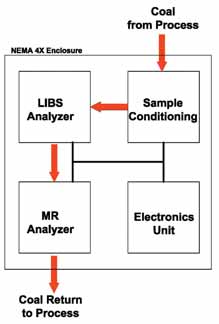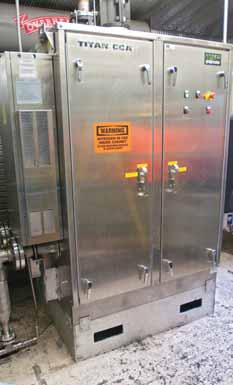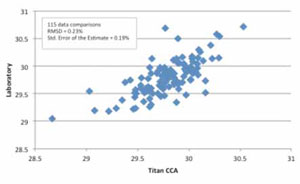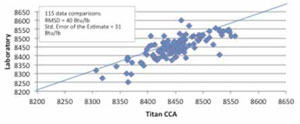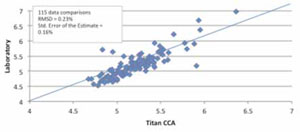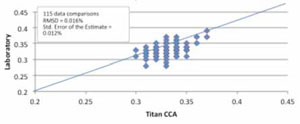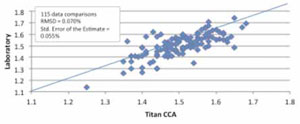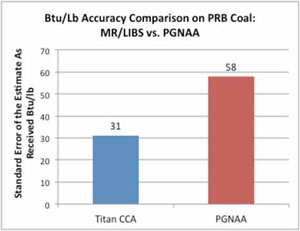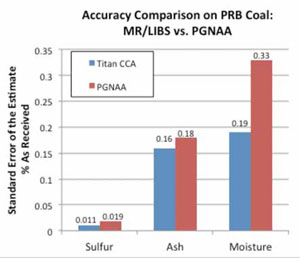Productivity growth in the U.S. coal
industry from 1985 to 2000 was
remarkable, from about 5,200 tons/
miner per year in 1985 to almost
15,000 tons/miner per year in 2000, a
compound annual growth rate of almost
8% per year (See Figure 1). Admittedly,
some of those efficiency gains can be
attributed to the Powder River Basin’s
increasing share of production and its
scale advantage. Yet, productivity
growth of 8% is hard to ignore. What’s
equally remarkable is that this growth
occurred without any significant break-throughs in mining technology.
Everything that characterized state-of-the-art mining equipment in 2000—
from longwalls to heavy media cyclones
to high-speed rail loadouts—already
existed in 1985, although belt speeds
and haul truck capacities continued to
increase, and mines derived improved
efficiencies from technologies such as
GPS tracking and wireless communica-tion. However, productivity declined in
the first decade of the 2000s and that
is to some extent reflective of the rela-tive lack of innovation and/or the
increased regulatory environment.
That same plateauing occurred in
the sampling and analysis part of the
coal industry. There haven’t been any
breakthroughs in sampling since the
sweep-arm sampler; lab analysis equip-ment is essentially the same as it was
in 1985; and online analyzers have
experienced only incremental improve-ment as well over that time period.
However, based upon some recent field
results at a large western U.S. coal
mine, that drought in innovation may
be about to end.
Mines Need
Timely Information
In early 2010, a Powder River Basin
(PRB) mine decided it was worth the
risk to try out a new online coal analy-sis technology. Like most PRB produc-ers this mine works two areas of the pit
simultaneously. Despite the widely-held
perception that coal quality is consistent at a given PRB mine, there can be
enough variation, especially in today’s
highly competitive market, to warrant
an online analyzer to monitor and
respond to real-time trends.
This mine has two adjacent truck
dumps from where the coal is trans-ported directly to the four loadout silos
by a 60-in. conveyor at rates of 3,000
to 6,000 t/h. A two-stage sweep-arm
sampling system is installed on this
belt to determine the coal quality enter-ing the silos. Physical samples are
taken every three to four hours and sub-jected to both quick and ASTM analy-ses. The quick analysis results (sulfur,
ash, moisture and Btu/lb) are available
approximately three hours later. The
ASTM results arrive up to 24 hours
after the sample was taken. For the
mine to respond to even the quick
analysis, it is reacting to data that is on
average almost five hours old.
The need for online analysis was
clear. Not only could a coal analyzer
provide prompt coal quality data to pit
operations for corrective action, it could
also give the control room operator
advance warning of impending prob-lems in satisfying the contract specs of
an upcoming train. Moreover, not only
was the quick lab analysis not really all
that quick, it also failed to include an
analysis of the Na2
O fraction in the ash,
itself a criterion for rejecting a train.
A New Solution
The new online analyzer that this mine
decided to test could not only detect
the low levels of Na
2
O that other online
analysis technologies cannot, but it
could also measure moisture directly,
without having to make any assumption
of bound moisture levels, as microwave
moisture meters must. The analyzer
itself operates on a sample stream;
hence, the logical location for the unit
was in the vicinity of the existing sam-pling system, where a sample could be
routed to the analyzer. (See Figure 2).
There are actually two technologies
deployed in the Progression Titan CCA:
Magnetic Resonance (MR) and Laser
Induced Breakdown Spectroscopy
(LIBS). MR has always held promise for
online moisture measurement; the chal-lenge was designing an analyzer that
could incorporate an analysis chamber
small enough for MR to operate. The
Titan CCA does just that with its 1.2-in.
diameter analysis chamber. The use of
LIBS for online elemental analysis was-n’t entirely new, with an Israeli compa-ny having done trials in South Africa a
few years ago without commercial suc-cess. The Titan CCA’s LIBS analysis, in
contrast, has shown excellent ability to
do elemental analysis.
Magnetic Resonance operates by the
rapid application and removal of Radio
Frequency (RF) electrical pulses within
a magnetic field. The technology is
equivalent to receiving a full body MRI
at a hospital—the difference being the
analyzer returns spectroscopy data
while the hospital MRI returns images.
This phenomenon provides precise
hydrogen proton measurements leading
to very accurate moisture measurement
and hydrogen proton inputs into the
calorific value determination.
LIBS operates by focusing a laser
into a second analysis chamber and
analyzing the spectrum of the vaporized
material (See Figure 3).
Not only can LIBS achieve accura-cies comparable to those of other ele-mental analysis technologies (primarily
PGNAA) for sulfur and the six major ash constituents (Si, Al, Fe, Ca, K and Ti),
but it also can measure Na and Mg,
which PGNAA cannot in most coals.
This in turn leads to better ash fusion
determination and more accurate base-to-acid ratio estimation.
Progression is anything but a novice
to these technologies. They have been
successfully supplying the petrochemi-cal market with MR technology for more
than 20 years. In 2004, the company
began working with some of the world’s
most knowledgeable LIBS experts in
the fields of space exploration, mining
and materials handling and government
labs. In that same year, Progression
first tested a commercial LIBS analyzer
on an over-the-belt configuration within
the minerals industry and today has
multiple MR systems operating within
the phosphate industry. The years of
real-world applications experience in
the mining industry contributed signifi-cantly in the development and design of
the Titan CCA.
The Titan CCA combines both tech-nologies in a single instrument, with
adjacent analysis modules for MR and
LIBS (See Figure 4).
The small footprint (64-in. wide by
24-in. deep) coupled with mechanical
conveying to the analyzer and pneumat-ic transport of sample streams from the
unit minimizes installation problems.
Considering that the unit operates on
minus 4 mesh sample streams, this ana-lyzer is most likely to be found in load-out towers, accepting either secondary or
tertiary reject streams.
The PRB mine discussed in this arti-cle actually tried out a prototype device
from Progression in 2010 and then
opted for a full production unit in the
fall of 2011. For a view of the installed
Titan CCA, see Figure 5.
As is typical of any established tech-nology being applied to a new market,
there were some teething problems dur-ing commissioning. These issues, asso-ciated with a reliable air supply to the
unit, coal sampling, and network con-nectivity had been satisfactorily
addressed by early 2012. The unit has
been running reliably since then.
The PRB mine with the Titan CCA
uses it in both feedback and feed-for-ward modes. They use a rolling average
of online analysis results to detect trends in sulfur, ash, moisture, Btu/lb
and Na2O ash fraction, and ascertain
whether any of the contract specs are at
risk. If they are, a team makes a quick
mitigation decision that may consist of
either guidance to the shovel operators
or in extreme cases reassigning one or
more haul trucks to the higher quality
location. In addition, the control room
operator tracks the silo qualities in real
time, looking for any trends that might
threaten a contract limit. He, too, can
direct a mitigation response, to restore
a cushion in coal quality vis-à-vis con-tract limits.
There are tangible benefits that the
analyzer brings to the mine. With the
analyzer, the mine has increased its
ability to communicate with the pit pro-duction operators and troubleshoot
quality variances, and they can more
readily respond to adverse quality
trends not apparent from the core data.
Having coal quality information on a
real-time basis is especially critical
when the mine is loading trains back to
back, in order to avoid backing up rail
traffic or losing a train altogether.
Analytical Results
Inasmuch as the mine already had a
two-stage sampling system on the silo
feed belt, lab vs. analyzer comparisons
for performance assessment were
straightforward. Performance data from
a three-week period in February 2012-March 2012 showed that the Pro-gression unit was outperforming other
elemental analyzers particularly in
calorific value and moisture, and of course in Na2
O as well, since PRB sodi-um levels lie below the detection
threshold for PGNAA analyzers.
Comparisons between the laborato-ry and the analyzer on three to four hour
batches on moisture, calorific value,
ash, sulfur and sodium are shown in
Figures 6a-6e.
Figures 6f and 6g draw a compari-son between the performance of the
Titan CCA analyzer and another analyz-er using PGNAA technology, also on
PRB coal. The PGNAA data was taken
from a published document from anoth-er analyzer supplier.
Summary
The coal industry has made great
strides in productivity over the past
quarter century, but it has done so pri-marily without the benefit of any major
technological or significant design
improvement in mining equipment.
Mining efficiency gains have been
largely of the incremental variety, as
opposed to step jumps. This has been
especially true with online analyzers.
However, there now appears to be an
innovative pair of technologies found in
a single instrument from Progression
Inc. that could be the process control
breakthrough the market has been wait-ing for.
Richard Woodward is a consultant,
specializing in online coal analysis,
www.woodward-consulting.com



